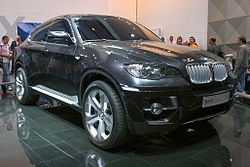BMW X6
 | |
| Manufacturer | BMW |
|---|---|
| Production | 2008-present |
| Assembly | Spartanburg, South Carolina, USA |
| Class | Mid-size crossover SUV |
| Body style(s) | 4-door SUV |
| Layout | Front engine / four-wheel drive |
| Platform | BMW E71 |
| Engine(s) | 3.0 L 306 hp I6 TT 4.4 L 407 hp V8 TT 3.0 L 235 hp I6 diesel 3.0 L 286 hp I6 diesel TT |
| Transmission(s) | 6-speed automatic |
| Wheelbase | 2933 mm (115.5 in) |
| Length | 4877 mm (192 in) |
| Width | 1979 mm (77.9 in) |
| Height | 1696 mm (66.8 in) |
| Related | BMW X5 |
The BMW X6 is a mid-size crossover SUV released for sale in the second quarter of 2008 by German automaker BMW. The X6 combines the attributes of an SUV (high ground clearance, all wheel drive and all-weather ability, large wheels and tires) with the stance of a coupé (bold styling, dramatic sloping roof).
Origins
It is built in BMW's North American plant in Spartanburg, South Carolina alongside the BMW X5 whose platform it shares. It is dubbed a "Sports Activity Coupé" by BMW, and while slightly longer and wider than the X5, it is significantly lower and seats only four people.The concept model debuted at the 2007 Frankfurt Auto Show. The production X6 officially debuted at the 2008 Detroit International Auto Show. A hybrid version, the BMW Concept X6 ActiveHybrid, which will be the first such vehicle from BMW, was also announced.
Model Range
Petrol-Engines
Initially, the BMW X6 is available in North America (Soon to be released in the UK) in two variants. Both use twin-turbocharged engines. The top-of-the-line model is the xDrive50i which uses an all-new 4.4-liter twin-turbocharged V8 engine. It produces 408 metric horsepower (300 kW) between 5,500 and 6,400 rpm, and 600 N·m (443 ft·lbf) of torque over a wide range of between 1,800 and 4,500 rpm. It is the first production turbocharged V8 engine in the world to feature its turbochargers between the V section in the middle of the two banks of cylinders.
The other model is the X6 xDrive35i powered by the N54 3.0-liter twin-turbocharged inline-six gasoline engine, producing 306 metric horsepower (225 kW) between 5,800 and 6,250 rpm, and a peak torque of 400 N·m (295 ft·lbf) between 1,400 and 5,000 rpm. This engine also sees duty in the 1, 3 and 5 Series BMW cars.
Diesel Engines
Two diesel variants have been announced, and are expected to constitute as much as 90% of sales volume in European markets. The models are called the xDrive30d and xDrive 35d, respectively. They are powered by BMW's 3.0-liter turbodiesel engine (in its sequential twin-turbocharged variant for the xDrive35d), and produce 235 PS (173 kW) in the xDrive30d and 286 PS (210 kW) in the xDrive 35d version. The second of these power units will form the basis of BMW's Diesel launch in all 50 states in late-2008.
Chassis Technology
Dynamic Performance Control
The X6 marks BMW's first use of its new Dynamic Performance Control system, which works in unison with xDrive all-wheel drive (both are standard on the X6). DPC is a drivetrain and chassis control system that works to regulate traction and especially correct over- and understeer by actively spreading out drive forces across the rear axle. Torque is split not only between the front and rear wheels (xDrive) but also from side to side at the rear for improved agility and added stability (through the DPC rear axle).
The DPC differential features clutch packs on both output sides that are actuated by an electric motor. The clutch pack activates a planetary gearset which causes one wheel to be overdriven. A conventional control system will use the brakes to reduce the speed of the faster moving wheel (which is the one with less traction)and reduce engine power. This leads to increased brake wear and slower than optimal progress. The DPC system speeds up the slower moving wheel (the one with the most traction) in order to maintain stability when needed. For example; while turning, the outer wheel is overdriven to provide greater acceleration using the traction advantage through the dynamic loading of the outboard wheel in cornering. In an oversteer situation, the inner wheel is overdriven to regain traction balance.
Dynamic Performance Control is currently unique in that it is effective when the X6 is both accelerating and decelerating, so at any speed and under any road condition. (Simpler active differential systems that react under power have been available in various -generally sporting- Japanese models for some time, for example Subaru Impreza WRX and the USA Honda Legend).




![Validate my RSS feed [Valid RSS]](valid-rss-rogers.png)















































































ไม่มีความคิดเห็น:
แสดงความคิดเห็น